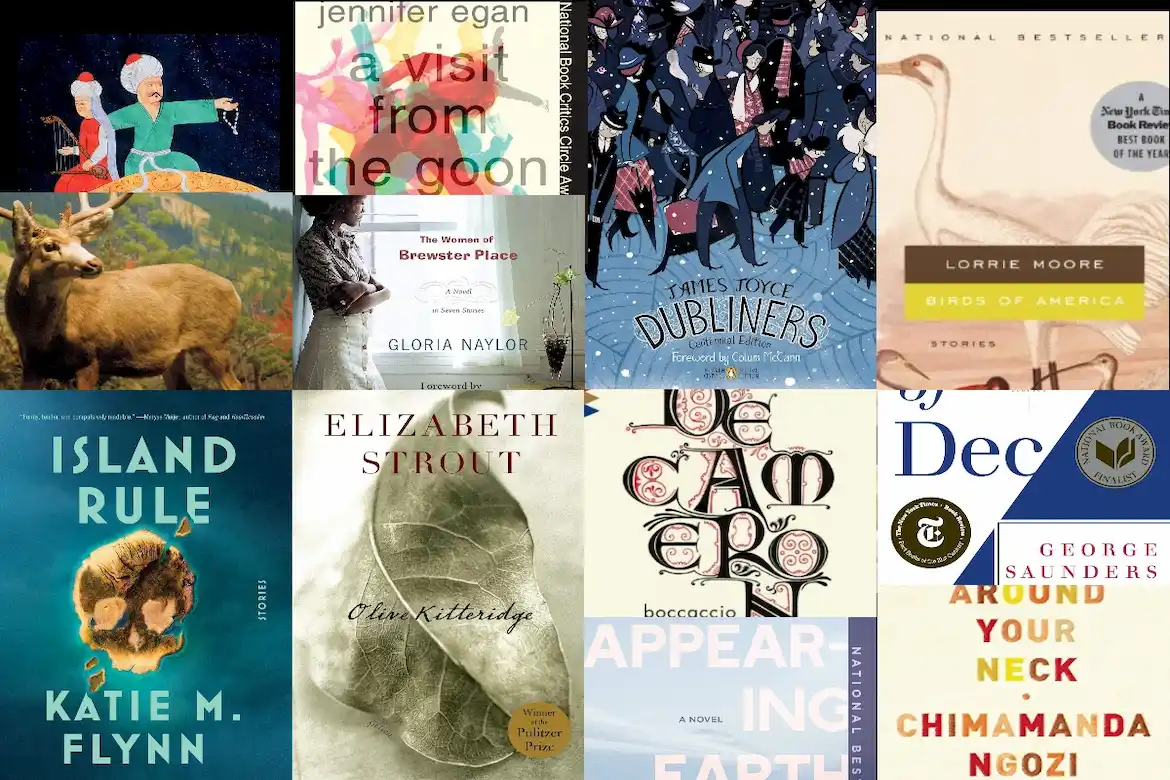You can find and buy the books we recommend at Bookshop on our list of LitStack Recs.

In This LitStack Rec of 12 Short Story Novels
A Tapestry of Interconnected Narratives
We believe these story collections are short story novels, using the short story to weave tales together with recurring characters, shared settings, or common themes, in order to create a unique overarching narrative arc. A short story novel might follow a timeline or simply connect through subtle links, and the stories are used to create the seamless narrative rise and fall found in the novel.
Authors use the short story novel form to craft stories that resonate deeply, building rich, novel-like worlds. It’s fascinating how these books blend the brevity of short stories with the depth of novels, resulting in a tapestry of interconnected narratives.
If you’re looking for something fresh and engaging, what we’re calling short story novels might just be your next favorite read. Here’s our LitStack Rec of Short Story Novels you should read, in no particular order, but numbered for ease of reference:
Olive Kitteridgeby Elizabeth Strout
“…deeply human and even sympathetic, as are all of the characters in this “novel in stories.” Covering a period of 30-odd years, most of the stories…feature Olive as their focus, but in some she is a bit player or even a footnote while other characters take center stage.”


Olive Kitteridge by Elizabeth Strout (2008)
In her 2008 short story novel, Olive Kitteridge, Elizabeth Strout crafts a vivid portrait of life in Crosby, Maine. This Pulitzer Prize-winning work consists of thirteen interconnected tales that together tell the story of Olive Kitteridge, a straightforward retired schoolteacher. Each narrative stands on its own but weaves into a larger tapestry that explores themes of human connection, aging, and loss. Through Olive’s eyes and her interactions with others, readers gain insight into the social fabric of this small town. As the stories unfold, one gains a deeper understanding of Olive’s impact on those around her and the community’s complex dynamics.
A Visit from the Goon Squadby Jennifer Egan
“If Egan is our reward for living through the self-conscious gimmicks and ironic claptrap of postmodernism, then it was all worthwhile. . . . [A] triumph of technical bravado and tender sympathy. . . . Turn up the music, skip the college reunion and curl up with The Goon Squad instead.”


A Visit from the Goon Squad by Jennifer Egan (2010)
In 2010, Jennifer Egan introduced readers to her innovative short story novel, A Visit from the Goon Squad. This book is a fascinating mosaic of interconnected tales set in the music world. Each chapter offers a fresh story, showcasing diverse narrative styles and perspectives. While these stories can stand on their own, they’re tied together by recurring characters and themes like the passage of time, memory, and how technology reshapes our relationships. The novel’s fragmented, nonlinear structure mirrors the way we recall memories, gradually unveiling a cohesive picture as patterns and connections emerge.
The Thing Around Your Neckby Chimamanda Ngozi Adichie
“The most powerful stories in this volume. . . demonstrates that [Adichie] is adept at conjuring the unending personal ripples created by political circumstance, at conjuring both the ‘hard, obvious’ facts of history, and ‘the soft, subtle things that lodge themselves into the soul.'”


The Thing Around Your Neck by Chimamanda Ngozi Adichie (2009)
Chimamanda Ngozi Adichie’s The Thing Around Your Neck, released in 2009, is a captivating short story novel that explores the depths of Nigerian identity and the immigrant journey. Through a series of interconnected tales, Adichie delves into themes of home, belonging, and cultural displacement. The recurring characters and shared themes create a rich tapestry that paints a vivid picture of the Nigerian experience on a global stage. This unique structure offers readers a deep dive into the complexities of navigating different cultural landscapes, making it both engaging and enlightening.
The Tenth of Decemberby George Saunders
“Saunders doesn’t neglect his gift for surreal situations. These are unpredictable, stealthily funny, and complexly affecting stories of ludicrousness, fear, and rescue.”


Tenth of December by George Saunders (2013)
George Saunders’ 2013 short story novel, Tenth of December, showcases a unique narrative structure by weaving thematic elements together rather than relying on shared characters or settings. This collection delves into themes such as empathy, social inequality, and the pursuit of human connection in an imperfect world. Saunders employs a satirical yet compassionate tone throughout the stories, presenting a consistent moral viewpoint. The result is a cohesive emotional and intellectual experience for readers. As one literary critic noted, “Saunders’ ability to blend humor with deep insight makes this work stand out.”
Disappearing Earthby Julia Phillips
“[An] immersive, impressive, strikingly original debut. . . an unusual, cleverly constructed …book about different women, all with the shadow of two missing girls hanging over them as a year goes by.”


Disappearing Earth by Julia Phillips (2019)
In her 2019 short story novel, Disappearing Earth, Julia Phillips explores the mysterious vanishing of two sisters on a secluded Russian peninsula. This event serves as a thread connecting the lives of several women in the community. Each chapter introduces us to a new woman over the course of the year following the sisters’ disappearance. Through these stories, we see the social ties, cultural intricacies, and underlying tensions of the area come to life. While the missing girls linger in the background, the intertwined tales offer a vivid depiction of a community grappling with loss and uncertainty. As readers, we’re invited to peel back the layers of this unique locale and discover the intimate details of its residents’ lives.
Island Ruleby Katie M. Flynn
“I think it’s a whole new way of looking at connections, deeply tunneled. I really can’t think of any other linked short story collections that do the same thing. A significant evolution” of the short story novel form.


Island Rule by Katie M. Flynn (2019)
Katie M. Flynn’s 2019 short story novel, Island Rule, takes readers on a journey to a fictional island off the coast of Maine. This secluded spot serves as the backdrop for a series of interconnected tales spanning decades. Each story zooms in on different islanders, offering glimpses into their lives and experiences.
Flynn skillfully weaves together recurring locations and local folklore, painting a vivid picture of the island’s unique culture and history. The island’s stark beauty isn’t just scenery; it plays an active role in shaping the lives of those who call it home. As you turn the pages, you’ll uncover how these individual stories merge into a broader narrative, revealing a community deeply connected to its environment.
With each tale, you peel back another layer of this tight-knit society, exploring themes like resilience, isolation, and the passage of time. The novel doesn’t just tell stories—it immerses you in the island’s world, making you feel the pulse of its identity through its people and their intertwined destinies.
Versatility is Endless
In the world of literature, short story novels are making waves with their creative approach. Authors use recurring characters, shared settings, and thematic links to weave a cohesive narrative that feels like a novel. This method allows readers to delve deeply into each individual story, gradually piecing together a richer understanding of the whole plot and its main themes. As readers, we become part of the storytelling process, connecting these seemingly standalone stories into one complete picture. It’s a fascinating way to explore the art of storytelling, where every piece plays a crucial role in the grand narrative. These next additional books using the short story novel form demonstrate significant versatility.
The Women of Brewster Placeby Gloria Naylor
“Naylor creates a completely believable, and very frightening, world of degradation, violence and human—very human—courage and sturdiness.”


The Women of Brewster Place by Gloria Naylor (1982).
Gloria Naylor’s 1982 novel, The Women of Brewster Place, is a standout example of how short story novels can craft a larger tale. Set on a dead-end street in an urban housing project, this book spotlights seven African American women. Each chapter unfolds as its own story, exploring the unique challenges and triumphs faced by each woman. Yet, despite their individual journeys, the shared backdrop of Brewster Place ties these narratives together, highlighting themes of race, class, gender, and community. Readers are drawn into the vibrant lives of these women, experiencing a narrative that ultimately paints a powerful picture of resilience and solidarity.
Pastoraliaby George Saunders
“Dazzling . . . Saunders’s misfits confront their degradations with heroic optimism; rarely have the comic nuances of suffering been tracked with such precision. These stories, injected with Saunders’s highly original blend of irony and tenderness, ride you down spirals of the absurd and fling you back to your own life, startled.”


Pastoralia by George Saunders (2000)
George Saunders’ 2000 collection “Pastoralia” is a standout in contemporary literature, cleverly blending short stories into a novel-like experience. Much like his later work, “Tenth of December,” this collection uses dark humor and deep empathy to explore the quirks of modern life. Saunders dives into the oddities faced by everyday people, especially those working hard to find meaning in strange situations. His unique voice ties these tales together, making each story feel both complete and part of a bigger picture.
“Pastoralia” shines a light on the absurdities of modern existence, showing the struggles and dreams of the working class as they deal with bizarre and challenging scenarios. Saunders’ sharp wit and compassion offer readers a clear view into the human condition. Each story, while distinct, connects to create a larger, insightful commentary on today’s world. Characters often find themselves caught up in bureaucratic nonsense or dealing with lost dignity, yet they all share a vulnerability and desire for connection.
Saunders’ skillful mix of humor and sadness, set in surreal or dystopian worlds, highlights what it means to be human. This collection not only entertains but also solidifies its place as an important piece of modern storytelling through its innovative approach to the short story novel.
Birds of Americaby Lorrie Moore
“Moore’s rapid-fire alternation of mirth and deep melancholy is so perfectly suited to the short form that readers will greet Birds of America with an audible sigh of relief–and delight.”


Birds of America by Lorrie Moore (1998)
Lorrie Moore’s Birds of America, published in 1998, is a masterful collection of short stories that feels much like a novel. The tales are woven together with the recurring presence of Trixie, a woman whose journey through life is marked by humor and heartache. Though the stories aren’t arranged in a traditional sequence, Trixie’s recurring appearances and the themes of love, loss, and the challenges faced by modern women create a cohesive emotional experience. This collection skillfully blends the depth of a novel with the concise charm of short stories.
Dublinersby James Joyce
“It is in the prose of Dubliners that we first hear the authentic rhythms of Joyce the poet…Dubliners is, in a very real sense, the foundation of Joyce’s art. In shaping its stories, he developed that mastery of naturalistic detail and symbolic design which is the hallmark of his mature fiction.”


Dubliners by James Joyce (1914)
While an earlier example, Joyce’s collection of fifteen short stories offers a powerful portrait of early 20th-century Dublin life. The stories are linked by setting, shared social and political contexts, and a thematic exploration of paralysis and disillusionment, creating a cohesive and insightful depiction of a city and its inhabitants.
James Joyce’s Dubliners (1914) stands as a seminal, albeit early, example of a contemporary novel constructed through the intricate weaving of interconnected short stories. This collection comprises fifteen narratives, each offering a focused glimpse into the lives of various inhabitants of early 20th-century Dublin. However, Dubliners transcends a simple anthology; it achieves a powerful cumulative effect, presenting a multifaceted and profound portrait of a specific time and place.
The interconnectedness of the stories is established through several key elements. Firstly, the shared setting of Dublin serves as a unifying backdrop, creating a palpable sense of the city’s atmosphere and its influence on the characters’ lives. Readers encounter familiar locales and a consistent social environment across the narratives. Secondly, the stories are subtly linked by shared social and political contexts. The pervasive Irish nationalism, the influence of the Catholic Church, and the emerging modern consciousness form an unspoken yet powerful framework that shapes the characters’ experiences and choices.
Perhaps most significantly, Dubliners achieves its novelistic structure through a thematic exploration of paralysis and disillusionment. This central theme resonates across the individual stories, manifesting in various forms of emotional, psychological, and societal stagnation. Characters grapple with unfulfilled desires, stifled ambitions, and a pervasive sense of entrapment within the confines of their circumstances. This thematic cohesion lends a profound sense of unity to the collection, transforming it into a comprehensive and insightful examination of the human condition within a specific cultural context.
Through the accumulation of these interconnected narratives, Joyce crafts a cohesive and resonant depiction of a city and its inhabitants, effectively employing the short story form to create a work that possesses the depth and scope of a novel.
Intimacy and Expansiveness Create Insightful Reading
The reading experience engendered by the short story novel form is often characterized by a sense of both intimacy and expansiveness. Each story offers a focused and complete narrative experience, allowing the reader to delve deeply into a particular character or situation. However, as the reader progresses through the book, the connections between the stories accumulate, creating a richer and more nuanced understanding of the overarching themes, characters, and world.
This form can mimic the way we experience life itself – in discrete moments and relationships that collectively form a larger, more complex narrative. It allows authors to explore multiple perspectives and temporalities in ways that a traditional linear novel might not, offering a fragmented yet ultimately unified vision. The reader actively participates in constructing the larger narrative by making connections and recognizing recurring motifs, leading to a uniquely rewarding and insightful reading experience.
Foundational Works in the Short Story Novel Form
Foundational works like Giovanni Boccaccio’s The Decameron and The Tales of the Arabian Nights (or One Thousand and One Nights) serve as significant forerunners and probable origins of the “short story novel” structure prevalent in contemporary literature. These early examples of interconnected narratives established the basis for subsequent evolution, notably employing a framing device to achieve a novelistic unity within their collections.
These early examples demonstrate interconnected storytelling and employ a framing device to achieve a novel-like unity, establishing a basis for this contemporary literary technique.
The Decamersonby Giovanni Boccaccio
“A lively, readable translation (by John Payne) of the greatest short story collection of all time. The laugh-out-loud quality of Boccaccio s delicious vernacular is admirably preserved.”


The Decameron (c. 1353) by Boccaccio.
Written around 1353, The Decameron is a fascinating blend of short stories and novelistic elements. Set against the backdrop of the Black Death, it follows ten young Florentines who, in an effort to escape the plague, share 100 stories. This frame narrative ties together diverse tales, creating a vivid picture of society and shared humanity in times of crisis. Through their storytelling, these characters reveal themes of resilience and creativity. The interactions among them weave individual stories into a cohesive whole, showing how shared experiences and the art of narration can unite separate narratives into a larger, novel-like structure.
The Tales of the Arabian Nights, 1001 Nightsby Anonymous
“A magnificent, unexpurgated edition (translated by Malcolm and Ursula Lyons) of the greatest collection of folk tales in the world . . . The Arabian Nights is not a book to be read in a week. It is an ocean of stories to be dipped into over a lifetime. And this Penguin edition is the one to have.”

The Tales of the Arabian Nights (c. 8th-14th centuries, with later additions)
The Tales of the Arabian Nights is a classic collection dating back to the 8th century, with some tales added later. This isn’t just any book; it’s a masterclass in blending the short story form with a novel-like structure. At its heart lies the clever frame story of Scheherazade, who spins captivating tales night after night to delay her fate at the hands of King Shahryar.
Each story she tells is packed with adventure, magic, love, and justice. Some tales even nest within others, creating layers of intrigue. While the links between these stories might not be as obvious as those in modern books, the ongoing saga of Scheherazade, combined with recurring themes, weaves them into a vast, interconnected world.
This collection shows how a strong narrative can unite a variety of stories, giving them shared meaning and power. It’s a testament to the timeless art of storytelling, where each tale contributes to a larger narrative tapestry.
Both works heavily rely on a frame narrative to give context and connection to the individual stories. This technique is still used by contemporary authors to link their short story cycles.
While the stories within these last two collections might vary, they often explore recurring human themes, contributing to a sense of thematic unity across the work.
Through the accumulation of individual stories and characters (even if they don’t always directly intersect), these collections create a rich and multifaceted portrayal of a society, a time period, or a set of cultural values, akin to the world-building in a novel.
While these are perhaps the most prominent early examples, the tradition of weaving together smaller narratives into a larger whole can be seen in other ancient and medieval works as well, such as collections of myths, legends, and folklore. However, The Decameron and The Tales of the Arabian Nights stand out for their sophisticated frame narratives and their conscious structuring of diverse stories within a unifying context, making them ancestors to the contemporary “short story as novel.”
A Deeper Cohesiveness?
In conclusion, the “short story novel” form offers a unique and enriching reading experience. It masterfully balances intimacy with expansiveness, providing focused narratives that accumulate into a broader, more nuanced understanding. Readers engage actively in synthesizing individual stories, recognizing recurring motifs, and constructing a larger narrative, much like piecing together the fragments of real life into a cohesive whole.
This form mimics our lived experience, where discrete moments and relationships build into complex narratives. It allows authors to explore diverse perspectives and timelines, offering a fragmented yet unified vision that a linear novel might lack. Ultimately, the “short story novel” form offers a rewarding and insightful journey, inviting readers to discover the intricate connections and profound depth hidden within its seemingly separate parts.
If you seek a reading experience that is both immersive and thought-provoking, explore the world of composite, or short story novels. These books challenge traditional narrative structures and invite you to participate in creating meaning. Dive into these rich tapestries of interconnected stories and discover the profound impact of the “short story novel” form.
~J.S. Hood
Other LitStack Resources
Be sure and look at our other LitStack Recs for our recommendations on books you should read, as well as these reviews by Lauren Alwan, and these reviews by Rylie Fong, Allie Coker, and Sharon Browning.
As a Bookshop, Malaprop’s, BAM, Barnes & Noble, Audiobooks.com, Amazon, and Envato affiliate, LitStack may earn a commission at no cost to you when you purchase products through our affiliate links.




